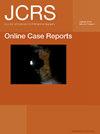Recurrent scleral-fixated intraocular lens dislocation with spontaneous repositioning produced by tilting and head movements
Q4 Medicine
引用次数: 0
Abstract
Introduction: An unusual case of a patient who could repeatedly reposition his dislocated sulcus poly(methyl methacrylate) intraocular lens (IOL) by head movements and tilting his body is reported. Patient and clinical findings: An 86-year-old man presented with a 3-year history of recurrent episodes of transient blurred vision and monocular diplopia in his left eye. 20 years previously, he had phacoemulsification cataract surgery complicated by posterior capsule tear, which was treated with anterior vitrectomy and a secondary scleral-fixated IOL. Over the previous 3 years, he had recurrent episodes of IOL dislocation. He could regain normal vision by tilting his head and trunk. The dislocated IOL was maneuvered into position by capturing the haptic into the residual capsular remnant by appropriate head movements. On examination, his corrected distance visual acuity (CDVA) was counting fingers, and the posterior chamber IOL was subluxated inferiorly. During presentation, he could not reposition it himself, warranting a surgical intervention. Diagnosis, intervention and outcomes: He underwent suturing of the IOL in the sulcus. The IOL was well-centered with a CDVA of 6/9. Conclusions: To the authors’ knowledge, this is the first case report of a patient who could repeatedly reposition a dislocated IOL through tilting and head movements.复发性巩膜固定型人工晶状体脱位伴倾斜和头部运动引起的自发重新定位
引言:报道了一例不寻常的患者,他可以通过头部运动和倾斜身体来反复复位脱位的聚甲基丙烯酸甲酯沟人工晶状体(IOL)。患者和临床发现:一名86岁的男性,有3年的左眼短暂性视力模糊和单眼复视复发史。20年前,他接受了白内障超声乳化手术,并发后囊撕裂,并接受了前部玻璃体切除术和二期巩膜固定IOL治疗。在过去的3年里,他反复发作IOL脱位。他可以通过倾斜头部和躯干来恢复正常视力。通过适当的头部运动将触觉捕获到残留的晶状体囊残余物中,将脱位的IOL操作到位。检查时,他的矫正远距视力(CDVA)为数指,后房型人工晶状体下方半脱位。在演示过程中,他自己无法重新定位,需要进行手术干预。诊断、干预和结果:他接受了人工晶状体沟缝合术。IOL居中良好,CDVA为6/9。结论:据作者所知,这是第一例通过倾斜和头部运动反复复位脱位IOL的患者报告。
本文章由计算机程序翻译,如有差异,请以英文原文为准。
求助全文
约1分钟内获得全文
求助全文

 求助内容:
求助内容: 应助结果提醒方式:
应助结果提醒方式:


